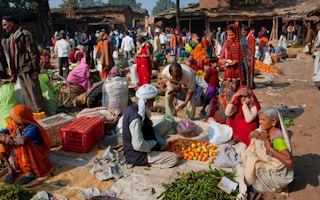NEW YORK – Food systems have gone global. The average North American meal now travels 2,400 kilometers (1,491 miles) from field to plate. As the food-supply chain has been transformed, efforts to ensure that it is accessible to all have intensified, with the “right to food” serving as an important driver of bottom-up change.
In September, India adopted a landmark law on food security, guaranteeing five kilograms of subsidized wheat, rice, and other foodstuffs monthly for two-thirds of the population, and enhancing support for pregnant women, schoolchildren, and the elderly. Though there are undoubtedly numerous holes in the system, treating access to food as a legal entitlement is an important step in the right direction.
Such progress, which extends far beyond India, follows a decade of global activism that has challenged the logic of existing food systems like never before. Since the Universal Declaration of Human Rights was adopted in 1948, political rights like freedom of speech have been widely claimed, while the right to food has been largely neglected.
To be sure, since the declaration was signed, a plethora of tools has been introduced in the effort to combat hunger. Some countries have opened their markets to imports; others have closed them. Many became dependent on food aid, while some acted on the conviction that eradicating hunger is merely a matter of fostering GDP growth. But such efforts have had limited success.
“
Unlike the top-down, technical solutions that policymakers have usually favored, a solution based on the concept of food as an entitlement, not a privilege, would involve – and empower – multiple actors
Meanwhile, the most powerful institutional tool has been neglected. Unlike the top-down, technical solutions that policymakers have usually favored, a solution based on the concept of food as an entitlement, not a privilege, would involve – and empower – multiple actors. Such an approach would be centered on upholding the right of all people to produce or gain access to food.
This approach has clearly found an audience in India, where millions of people live in hunger and poverty, even as the country’s net wealth grows. Over the last decade, a right-to-food movement has taken root in the country, putting pressure on policymakers and approaching the problem from legal and political angles.
In 2001, a lawsuit brought by public-interest NGOs resulted in the Indian Supreme Court recognizing the right to food as an aspect of the constitutionally protected “right to life.” The court ruled that a series of social programs should be expanded, in order to provide a basic nutritional floor for all. This activated a virtuous circle; by strengthening the social movements rallying around the right to food, the Supreme Court’s decision enabled them to ratchet up pressure on state governments to build an effective food-security apparatus.
The recent law is a milestone in this process, but by no means the end point. In a country characterized by massive regional wealth disparities and deep-rooted poverty, the road to eradicating hunger is sure to be long and difficult. The key to ensuring continued progress is to establish accountability. In this sense, the social audits used by India’s Right to Food Campaign to assess compliance with court-mandated policies, such as the delivery of school meals, will be essential in the coming years.
Peasant farmers, parliamentarians, civil-society groups, and institutional actors have come together in similar ways elsewhere – including in Brazil, South Africa, and Mexico – to demand legal protections against hunger. Right-to-food framework legislation has been adopted in Argentina, Guatemala, Ecuador, Brazil, Venezuela, Colombia, Nicaragua, and Honduras. This has often led to the kind of participatory approach to policymaking that empowers the poor and enables lasting inroads against hunger to be made.
In Brazil, for example, civil-society representatives comprise two-thirds of the National Council on Food and Nutrition Security, and thus have the opportunity to influence policymaking at the highest level. In Mexico – where the right to food was constitutionally recognized in 2011 – an inter-ministerial commission includes 19 government departments and institutions. It is no coincidence that these countries now boast bold social programs that are dramatically reducing hunger among the poorest groups.
Clearly, courts have made a signal contribution to the fight against hunger, by upholding and making fully operational the right to food. In 2012, South Africa’s High Court ordered a revision of fisheries legislation to protect the livelihoods of small-scale fishers. In Nigeria, Argentina, and Nepal, the right to food has recently been invoked on behalf of regions and population groups – including indigenous peoples – whose access to food was threatened.
Breakthrough crops, fertilizer subsidies, and aid campaigns may grab the headlines, but it is the right-to-food movement that holds the greatest promise for ending hunger. The good news is that its power is only just being realized. With a truly global right-to-food movement now emerging, the best is yet to come.
Olivier De Schutter is the United Nations Special Rapporteur on the right to food. This post originally appeared here.

















